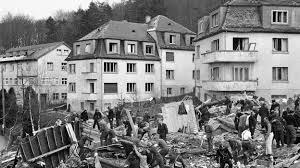
Today is the anniversary of the bombing of Zurich by US squadrons. Allied bombs claimed 84 lives altogether in Switzerland between 1940 and 1945. The tale of British and American air forces acting deliberately has survived to this day. But it is now absolutely clear that the bombing was based on errors and was not a reflection of the economic policy of the time. In recent weeks and months, the Allied strategic bombing offensive against Nazi Germany has been given prominent coverage in the German and English language media. The devastating Allied aerial warfare became the subject of passionate debate among historians and the general public alike, like recently, on the anniversary of the bombing of Dresden. Allied bombs also hit Zurich. The most violent bombing took place on March 4th, 1945 by six American Liberator bombers. When the air-raid alarm sounded on that fateful Sunday morning in Zurich at 9.32 a.m., hardly anyone believed it was a real attack, as the sirens had already sounded 400 times since the outbreak of the war. But the 392nd Bomber Squadron’s six planes, which had been flying from Winterthur towards Zurich, dropped bombs on the Strickhof agriculture school area at 10.19 am. Two houses were completely destroyed, and considerable material damage was done on over 50 others. The bombs claimed five lives and injured 15 people. As with the bombing of Schaffhausen in 1944, the Americans had been caught by the bad weather. On this March 4th, over 1000 bombers were supposed to have bombed targets in Southern Germany. Because of the dense clouds and fog, most squadrons returned to their bases without having found their targets. However, the crews of some scattered planes tried to find alternative targets. The inexperienced crews mistook Zurich for the German target of Pforzheim, due to bad conditions and radar equipment failure, and mistakenly dropped their bombs, which struck ground near the Strickhof agriculture school. After the attack, rumour spread in Zurich that the bombs were intended for a Nazi propaganda centre. This allegation was supported by the discovery of a swastika flag amongst the rubble. Not until later did it turn out that members of a family living in the destroyed house had brought the flag back from Germany, because they did not want to throw away "such good textiles". After the attack, the concerned American pilots and navigators were court-martialed in England, where they were accused of gross negligence for bombing a neutral nation. After two days of negotiations, however, the crews were acquitted; although they had acted negligently, the available evidence was not sufficient for punishment, the investigative commission ruled. The two bombings of Zurich by British squadrons had previously given rise to speculation. On December 23rd, 1940, bombs had fallen on the railway viaduct in Josefstrasse, killing one person and injuring several others. In addition, the Maag cogwheel factory was also hit by over 50 incendiary bombs. Rumours spread immediately: didn’t the Maag factory deliver sensitive armaments to Germany, and weren’t the coal transports from Germany, which were important toItaly, carried out via this railway network? Records from London archives prove that this attack was also a tragic mistake. That night, 29 Wellington bombers were sent out to bomb the engine works in Mannheim. Bad weather forced some of the planes to seek alternative targets. The fact that one of the bombers went off course in a southern direction and apparently saw a suitable alternative target in Zurich is also confirmed by Swiss aircraft radio station reports. The second bombing by British planes took place during the night of May 18th, 1943. Again, the location of the impacts raised great alarm, as they were located near Werkzeugmaschinenfabrik Oerlikon and along the railway line Seebach-Affoltern-Wettingen. Were the bombs aimed at the Bührle Group? Were these bombs dropped due to increased exports to Germany? Both the general public and the literature available in Switzerland to date did not rule out this "warning shot theory". Once again, British sources are able to provide us with information: On the night of May 18th, 1943, three Mosquito-type light bombers took off from their base in eastern England to launch a mock attack on Munich. While two crews claimed to have dropped bombs on Munich, the third crew could not identify their primary target. Thus, on the return flight, Strasbourg was bombed, having been a frequent alternative target. However, since no bombs were detonated in Strasbourg that night, it is reasonable to assume that a darkened Zurich was also mistaken for this secondary target in occupied France. Since Zurich was out of radio range that made precise navigation to German targets possible, a night-time precision attack by a single aircraft would have been impossible. All in all, Switzerland got off relatively well during aerial warfare over Europe, despite 84 deaths and various property damage. With contemporary navigation, primitive by today's standards, correct navigation and target location in bad weather was hardly possible for the often inexperienced crew, especially under bad weather conditions. In today's point of view, the Allies can no longer be accused of any intention. The crews involved, however, acted with the highest degree of gross negligence. Excluding the deliberate Royal Air Force overflights to its northern Italian and southern German targets, bombing of Switzerland during the Second World War can most aptly be summarised under the recently overused term "collateral damage".